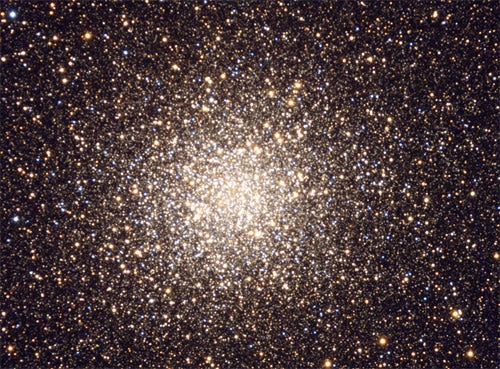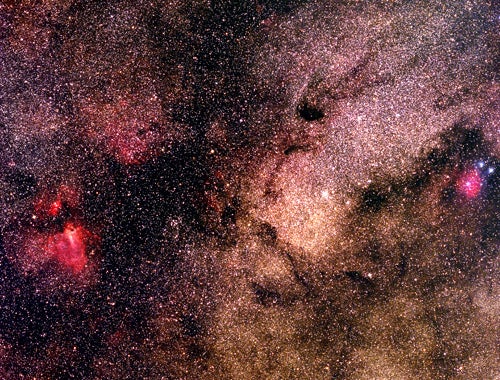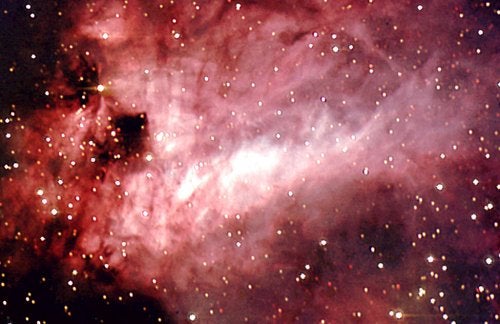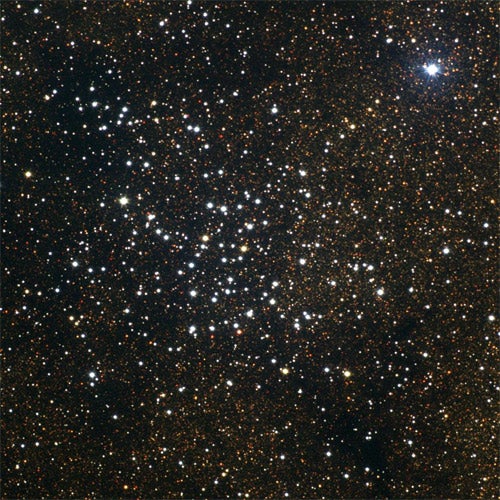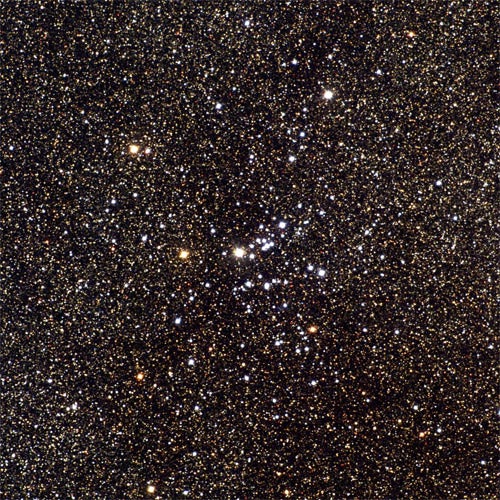The August “I’m a little teapot” features three of the finest deep-sky objects Sagittarius has to offer to binocular stargazers, but those are just the beginning. Other celestial wonders await near the celestial teapot.
M22
Look for this globular cluster about half a binocular field to the northeast of Kaus (ε) Borealis, the star at the top of the Sagittarius teapot. Binoculars easily show a brighter core surrounded by a nebulous disk of light.
Look for this globular cluster about half a binocular field to the northeast of Kaus (ε) Borealis, the star at the top of the Sagittarius teapot. Binoculars easily show a brighter core surrounded by a nebulous disk of light.
M24
Also known as the Small Sagittarius Star Cloud, M24 can be seen with the naked eye from dark, rural locations as a bright area along the Milky Way not far to the north of the teapot’s lid. Overall, M24 paints a pretty scene through binoculars. With the slightest magnification, the whole area disintegrates into countless points of light of many magnitudes. Be sure to look for the kite-shape asterism of stars within.
Also known as the Small Sagittarius Star Cloud, M24 can be seen with the naked eye from dark, rural locations as a bright area along the Milky Way not far to the north of the teapot’s lid. Overall, M24 paints a pretty scene through binoculars. With the slightest magnification, the whole area disintegrates into countless points of light of many magnitudes. Be sure to look for the kite-shape asterism of stars within.
M17
From the “kite” inside M24, look to the north for a slender, south-pointing triangle of dim stars. M17 is just to the triangle’s east. Seven-power binoculars should be able to make out a conspicuous “bar” of light oriented more or less east-west within the glow of the nebula. Giant binoculars, or smaller glasses if supported steadily, may add a “reverse hook” curving off the western end of the bar.
From the “kite” inside M24, look to the north for a slender, south-pointing triangle of dim stars. M17 is just to the triangle’s east. Seven-power binoculars should be able to make out a conspicuous “bar” of light oriented more or less east-west within the glow of the nebula. Giant binoculars, or smaller glasses if supported steadily, may add a “reverse hook” curving off the western end of the bar.
M23 is a rich open cluster compressed into an area that appears as large as the Full Moon. Most binoculars resolve a few of its brightest points just breaking through a haze created by other cluster suns that are too faint to be seen separately. M23 lies to the north of M20 and M21, and to the west of M24.
N.A.Sharp, REU program / NOAO / AURA / NSF
M23
M23 is a rich open cluster compressed into an area that appears as large as the Full Moon. Most binoculars resolve a few of its brightest points just breaking through a haze created by other cluster suns that are too faint to be seen separately. M23 lies to the north of M20 and M21, and to the west of M24.
M23 is a rich open cluster compressed into an area that appears as large as the Full Moon. Most binoculars resolve a few of its brightest points just breaking through a haze created by other cluster suns that are too faint to be seen separately. M23 lies to the north of M20 and M21, and to the west of M24.
Open star cluster M25 lies north of M22, or about one binocular field north of the tip of the Teapot’s lid. Among its many stars, M25 contains a Cepheid type variable star known as U Sagittarii, which cycles between 6th and 7th magnitude in 6.67 days. See if you can follow its fluctuations over several nights by comparing it to other stars within the cluster. Look for U Sagittarii to the east-northeast of the cluster’s center.
Hillary Mathis, Vanessa Harvey, REU program / NOAO / AURA / NSF
M25
Open star cluster M25 lies north of M22, or about one binocular field north of the tip of the Teapot’s lid. Among its many stars, M25 contains a Cepheid type variable star known as U Sagittarii, which cycles between 6th and 7th magnitude in 6.67 days. See if you can follow its fluctuations over several nights by comparing it to other stars within the cluster. Look for U Sagittarii to the east-northeast of the cluster’s center.
Open star cluster M25 lies north of M22, or about one binocular field north of the tip of the Teapot’s lid. Among its many stars, M25 contains a Cepheid type variable star known as U Sagittarii, which cycles between 6th and 7th magnitude in 6.67 days. See if you can follow its fluctuations over several nights by comparing it to other stars within the cluster. Look for U Sagittarii to the east-northeast of the cluster’s center.

